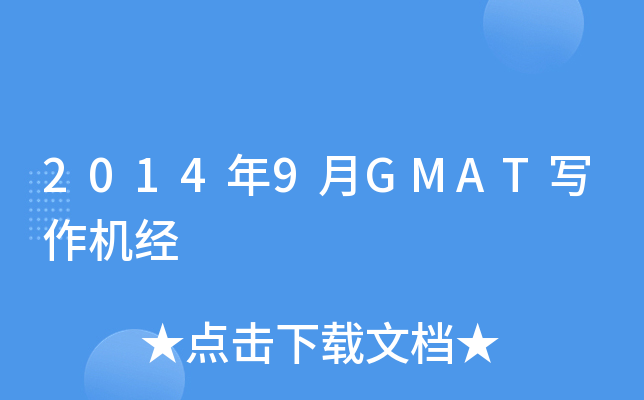一、换代言人(同上月27)
本月原始
公司市场总监说,过去的campaign很成功increase in sales,在开始4年成功用体育明星代言,吸引了中老年消费者,而后2年sales remained stable。 为了another increase in sales, 公司应该hire 某个乐团代言,因为他们是当下music sensation,来吸引untapped youth market。这样公司就能又increase in sales了。
考古
V1.引言:director 写给 CEO的(卖 grooming product的公司)
内容:公司四年前请了知名运动员作为代言人,销量上升了,but in the last two years 销量保持不变,如果想要在一次是销量提升,要再请个代言人。此外,这次要请DC,他是当下年轻人欢迎的歌星,我们要将目标人群有中年消费者转向年轻人。
V2.Company's cologne has experienced significant sales increase of 30% annually in the first four years of its launch. The company uses advertising campaign with professional sports stars and research found that most customers are middle-aged men. Cologne sale slowed down in recent years and CEO believes that they need to get younger people to use the cologne and he will hire Justin Bieber as their new spokesperson to achieve this.
参考思路
1.错误因果关系:代言人和销量上升。也许香水本身的定位就是中年男性,比如味道或者价位,换代言人并不会产生多少改变。销量不变可能是其他很多原因造成的,比如economic recession等等。
2.时地全等:过去用代言人这招管用,不代表将来还是有用, 也许其他很多竞争者都用这招了。last two years销量不变不代表以后销量也不变。
3.无关假设:歌星一定能吸引年轻人。没有证据支持这种说法,年轻的明星并不代表就能吸引到年轻男人,比如可能一般男生关注明星比较少,或者在男生中其实运动员更受欢迎,换了还不如不换。
二、Oak City
本月原始
V1.一个editorial,讲Oak城(什么,橡树城?)市中心建了shopping mall以后出现各种症状,1商铺倒闭2停车位不够3抓到的罪犯变多。所以咱们E城不应该建这种。
V2.好像是说在oak城建shopping mall后各种弊端,因此在elm城考虑不要建。
考古原题!!(OG13第52个)
The following editorial appeared in the Elm City paper:
"The construction last year of a shopping mall in downtown Oak City was a mistake. Since the mall has opened, a number of local businesses have closed, and the downtown area suffers from an acute parking shortage, and arrests for crime and vagrancy have increased in the nearby Oak City Park. Elm City should pay attention to the example of the Oak City mall and deny the application to build a shopping mall in Elm City."
Discuss how well reasoned .... etc.
Elm城的报纸上的社论:
去年在橡树城市中心修建购物中心是个错误。由于中心开业,大量的本地企业倒闭了。而且市中心受到严重缺乏停车位的困扰。在附近的橡树城公园拘捕的罪犯和流浪汉也增加了。榆树城应该注意橡树城购物中心的例子并防止在榆树城建立购物中心。
参考思路
1.错误因果关系:不一定是由于mall open导致其他商店关闭
2.时地全等:Elm City与Oak City不可完全等同
3.忽略了带来的好处,例如create new occupations
参考例文
In this editorial the author rebukes Oak City for allowing the construction of a new downtown shopping mall. Citing a number of problems that have occurred since the building of the mail, the author concludes that the residents of Oak City have not benefited from the mail and that Oak City exercised poor judgment in allowing the mail to be built. Among the problems cited by the author are the closure of local businesses, lack of parking in the downtown area, and increased trash and litter in a city park near the mall. Moreover, the author argues that profits derived from sales are not benefiting Oak City because the owner of the mall lives in another city. The author's argument is problematic in several respects.
In the first place, the author assumes that addition of the new mall is the cause of the various problems cited. The only evidence offered to support this claim is that the construction of the mall occurred before these problems manifested themselves. However, this evidence is insufficient to establish the claim in question. A chronological relationship is only one of the indicators of a causal relationship between two events.
In the second place, the author has focused only on negative effects the malt has had on the city. A more detailed analysis of the situation might reveal that the positive benefits for the city far outweigh the problems on which the author focuses. For example, new jobs might have been created for the residents of Oak City, and tax revenues might have been increased for the city. Lacking a more comprehensive analysis of the impact of the mail on Oak City, it is presumptuous on the part of the author to conclude that Oak City's decision to allow the mall to be built was incorrect.
In conclusion, the author's argument is unconvincing. To strengthen the argument the author would have to demonstrate that the construction of the mall caused the various problems mentioned. The author would also have to show that the negative effects of the project outweighed the positive effects.


